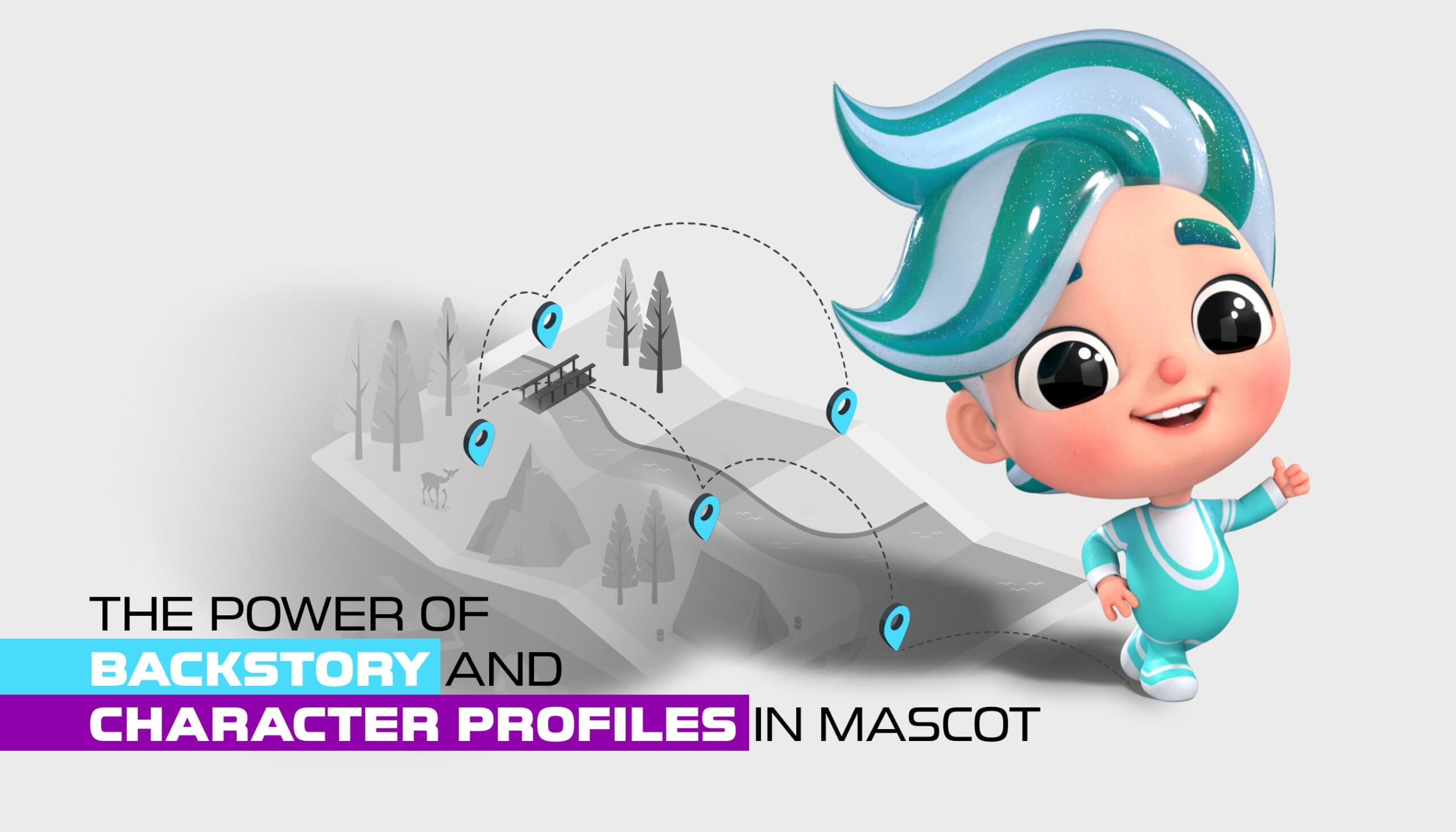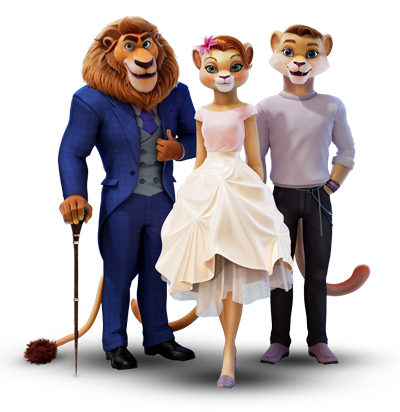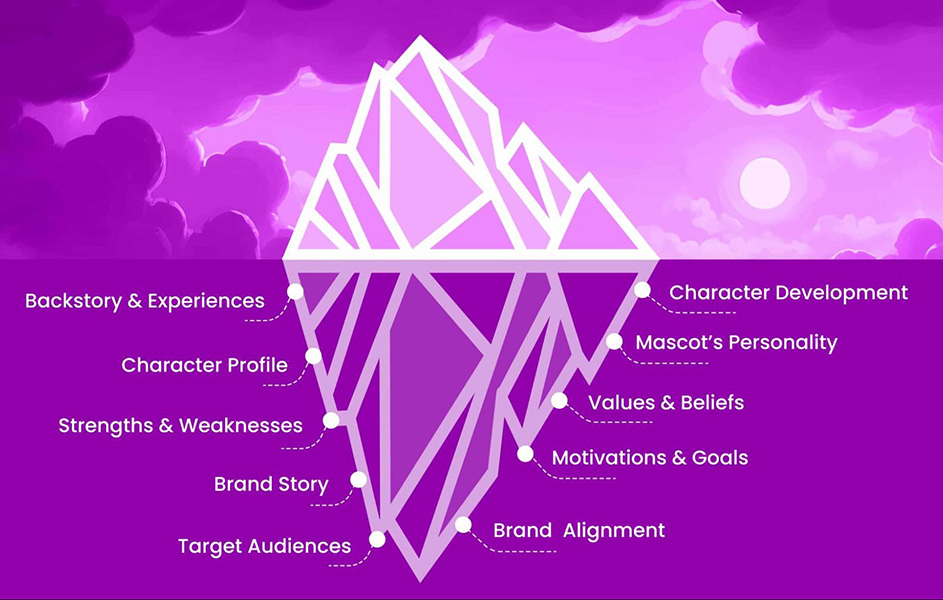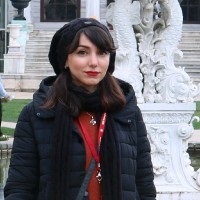
- What is the backstory?
- What is the importance of an effective and strong backstory?
- Linking Backstory to Brand Storytelling
- How can we align our mascot backstory with brand narratives?
- What is a character profile, and why is it important?
- What are the essential elements of Mascot Profiles?
- What are some Do’s and Don'ts to consider when creating mascot profiles?
- Conclusion
Stories are all about the characters—they’re what you remember most. And just like in stories, company mascots represent what the company is all about. To truly leverage their power, it’s vital to understand what brand mascots are and their foundational role. In this blog, we’ll dive into what a backstory is, how it links to a character profile, and ways we can leverage them for mascots.

What is the backstory?
A backstory is essentially the history or background story of a character, concept, or person. It provides context and depth, explaining why they are the way they are or how they came to be in their current situation.
Providing a mascot with a backstory enhances their human-like qualities, making them more relatable and memorable. This typically highlights its unique characteristics, behavioral patterns, and the profound relationship it shares with the brand.
By incorporating the mascot’s backstory and motivations, the brand manages to construct a multifaceted character that appeals to viewers and whose actions and demeanor make sense. This deeper connection is essential because it turns the mascot from an ineffective marketing strategy into a cherished and powerful brand advocate.
What is the importance of an effective and strong backstory?
An effective and strong backstory is important for various reasons, particularly in storytelling, branding, and character development. In the following section, we will explore its significance and provide its key points.
Emotional Connections
A relatable backstory serves as the foundation for creating a strong emotional link between the mascot and its audience. When the audience can identify with the mascot’s experiences and problems, it develops a sense of shared understanding and connection.
This emotional relevance extends beyond love for the mascot’s design or catchphrases, touching on deeper human feelings like empathy, compassion, and nostalgia. As a result, buyers build strong brand loyalty, seeing the mascot as a valued companion on their purchasing journey rather than merely a symbol.
Credibility and Believability
Realistic backstories play a pivotal role in enhancing the credibility and believability of the mascot.
When the backstory aligns with the audience’s expectations and experiences, it creates a sense of authenticity that resonates deeply with them.
Additionally, when consumers believe the mascot is believable, they are more inclined to connect with the company’s messaging and services, resulting in enhanced brand affiliation and loyalty.
Character Development
Having rich backstories is crucial for character development. Exploring a mascot’s background, personality characteristics, and motivations allows us to create deeper and realistic characters. This depth allows audiences to empathize with mascots, forming emotional connections with their stories.
Brand Differentiation
There is no shadow of doubt that in a competitive market, where there is fierce competition, brand distinction is highly critical for standing out in a crowd and gaining customer attention. Unique backstories help companies separate themselves from the crowd by emphasizing their originality and ideals. Marketers can design mascots that represent the essence of a brand in a distinctive and memorable way by building backstories that reflect its history, principles, and objectives.
Deeper Engagement
The foundation of effective brand communication is an engaging story which captures consumers’ interest and maintains their commitment to the company over time. Brands may craft compelling narratives that connect with consumers and encourage them to engage with the brand more deeply by utilizing captivating backstories.
If you’re thinking about adding a mascot to your communication plan, our team is here to help.
With over 10 years of experience and the development of more than 2,500 characters, we’ll guide you through every step to unlock the full potential of your new team member!
Learn more
Linking Backstory to Brand Storytelling
The link between a mascot’s backstory and the brand storytelling is very important in shaping the story and the brand experience as a whole. The history of the mascot can be seen as the story of how the brand’s personality, values, and purpose came to be. The mascot’s history sets the stage for the brand’s journey and growth, just like a character’s past affects what they do and how they make choices in a story.
A brand builds a unified and engaging brand narrative by including the mascot’s backstory in its storytelling. The backstory connects several aspects of a brand, like marketing efforts, product launches, and customer encounters.
Overall, connecting the mascot’s history to the brand’s story is important for making brand experiences that are real, accessible, and lasting. Not to mention, the background of your mascot should support the main idea of your brand story. Companies can make a strong brand personality that connects with customers on a deeper level by linking up the two stories.

How can we align our mascot backstory with brand narratives?
The efficacy of your marketing increases while maintaining consistency and clarity when you align your mascot’s backstory with the brand narrative. Here are several techniques for aligning these elements:
- Create a Complementary Backstory: Give your mascot a backstory that enhances and reflects the identity and values of your brand. For instance, if technological advancements are important to your company, your mascot’s creation story may take place in a cutting-edge scientific facility.
- Define Core Brand Values and Identity: Start by clearly defining your brand’s core values, mission, and identity. What does your brand stand for? What are its key messages? Understanding these foundational elements is crucial for creating a mascot that embodies and reinforces them.
- Keep tone and language consistent: The communication style and behavior of your mascot should complement your brand’s established tone. Having a mascot that is too formal could be unpleasant if your business is recognized for being welcoming and easygoing.
- Leverage the Mascot’s Story in Marketing Efforts: Incorporate the mascot’s background into social media posts, promotions, and advertising to improve your marketing initiatives. At the end of the day, this strategy strengthens the brand’s story across various media
What is a character profile, and why is it important?
Character profiles are thorough descriptions that influence how brand mascots seem and act. They provide information about the mascot’s appearance, personality, and communication style. These profiles provide a detailed mascot image, making it more relevant to the audience. They also help to ensure that the mascot is presented consistently in advertisements, on social media, and elsewhere. Mascots with defined character profiles become effective brand advocates, interacting with people meaningfully and developing loyalty.
Furthermore, character profiles help to define brand identity by expressing the brand’s values, voice, and overall attitude. When the mascot’s characteristics are directly related to the company’s identity, they function as powerful symbols reinforcing the brand message and connecting with the target audience. Consistency in depicting the mascot based on their character profile increases brand recognition and builds customer trust and loyalty.
Moreover, character profiles play a vital role in enhancing consumer engagement. Mascots with well-defined character profiles are more relatable and appealing to consumers, as they possess traits and qualities that resonate with their target audience. Whether it’s through humor, empathy, or authenticity, mascots that embody relatable characteristics can effectively connect with consumers on an emotional level, driving engagement and fostering meaningful interactions.
What are the essential elements of Mascot Profiles?
- Archetype
- Personality and characteristics
- Tone of voice
- Color scheme
- Appearance

Archetype
Archetypes are what give the mascot its basic nature and the part it plays in the brand’s story. Choosing an archetype—like the hero, the teacher, the clown, or something else—affects how the mascot interacts with people and how it expresses the brand’s values and messages.
Personality and characteristics
The mascot’s personality and attributes influence its actions, behaviors, and overall attitude. These characteristics should be consistent with the brand’s identity and relevant to the target audience. For example, a mascot for a fun and energetic business may be lively and extroverted, while a mascot for a luxury brand may be complicated and polished.
Tone of voice
The mascot’s tone of voice in communication helps to strengthen its individuality and successfully deliver the brand’s message. Whether the tone is warm, relaxed, professional, authoritative, or fun and witty, it should always represent the brand’s overall style and appeal to the target demographic.
Color scheme
The color palette used in the mascot’s design plays a crucial role in visual branding. Different colors evoke different emotions and associations, so selecting the right color scheme is essential for conveying the desired brand image and connecting with the audience.
Appearance
When we talk about appearance, we’re referring to the physical attributes and visual design of the mascot, such as its shape, size, attire, accessories, and overall look. It should be visually appealing, memorable, and reflective of the brand’s identity and principles.
What are some Do’s and Don’ts to consider when creating mascot profiles?
Let’s go over some essential guidelines and avoidable mistakes while creating mascot profiles. By following these do’s and don’ts, companies can guarantee that their mascots are real, relevant, and in line with their company identity and goals.
Do’s
- Research your audience: Understand your target audience’s tastes, values, and interests in order to build a mascot that appeals to them.
- Align with the brand identity: Make sure the mascot’s attitude, look, and communication style are in line with your brand’s identity and values.
- Keep It Simple: Make a clear and immediately identifiable mascot design that is memorable and simple to understand.
- Add depth: Create a narrative and personality features for the mascot to make it more appealing and accessible to your target audience.
- Test and iterate: Gather input from your audience and make changes to the mascot profile depending on their replies to guarantee its efficacy.
Don’ts
- Overcomplicate: Avoid designing an extremely complicated or difficult-to-grasp mascot since this may confuse or repel your target audience.
- Stray from Brand Identity: Avoid designing a mascot that contradicts or undermines your brand’s identity and values.
- Neglect Research: Don’t overlook studying your target audience’s tastes and hobbies since this knowledge is critical for developing a mascot that speaks to them.
- Lack of Depth: Avoid creating a mascot without a background or personality features since this will result in a bland and unappealing figure.
- Ignore Feedback: Do not disregard audience feedback or neglect to iterate on the mascot profile based on their comments, as this can result in missed possibilities for improvement and engagement.
Conclusion
Finally, brand mascots are effective representations of a company’s values and communications, with the ability to captivate viewers, increase consumer attachment, and distinguish the business from rivals. This study examined the importance of backstory and character profiles in creating memorable and compelling brand mascots.
If you are aiming to enhance your brand strategies, we at Dream Farm Agency offer a full range of services, such as brand mascot design, creative digital solutions, and interactive media solutions, all of which are executed in a way that allows your brand to resonate with your target audiences. Whether you are trying to launch a new product or rebrand an existing one, our services are meticulously designed to ensure your brand captures attention in the marketplace.

EliCreative Director
PoryaContent Writer




Interesting article! I really appreciate how a compelling backstory can bring mascots to life. In your experience, what aspects of a mascot’s story resonate best with audiences here in Europe?
Thanks! Yeah, a good backstory is crucial.